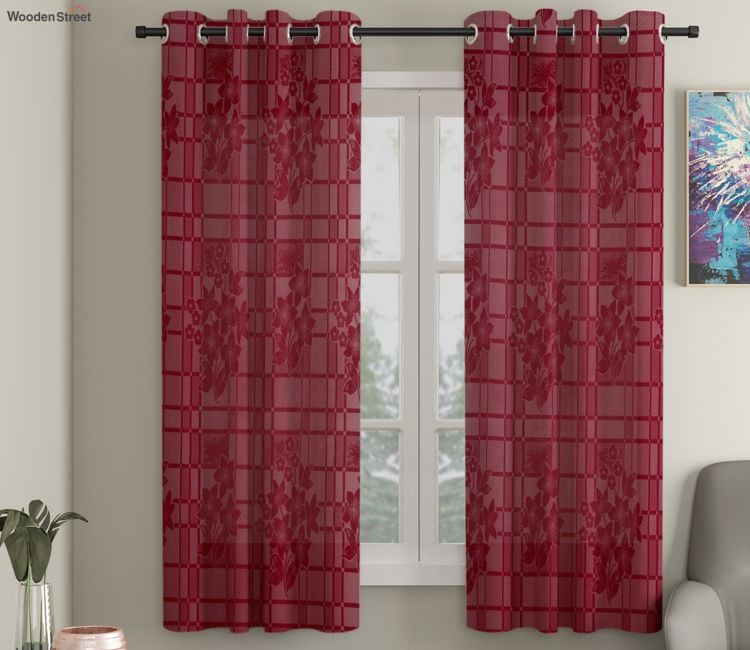Curtains are more than just decorative pieces—they’re essential elements that define the mood and functionality of a space. Especially in Indian homes, where climatic variations, privacy needs, and design preferences differ from region to region, choosing the right window curtains becomes crucial. The right curtain fabric not only enhances your interior décor but also helps in controlling light, maintaining privacy, and improving energy efficiency.
In this guide, we’ll walk you through the most popular window curtain fabrics, explain their pros and cons, and help you decide which ones are best suited for your Indian home.
Why Fabric Matters in Window Curtains
Curtain fabric impacts everything from light filtering and heat insulation to how a curtain drapes and lasts over time. While the color, length, and design play a role in décor, it's the fabric that determines functionality.
Key factors to consider when choosing curtain fabric:
- Climate adaptability
- Light filtration or blackout properties
- Maintenance and durability
- Aesthetic appeal
- Cost and availability
Let’s explore popular curtain fabrics available in India and where they work best.
1. Cotton Curtains – Simple, Breathable & Versatile
Cotton is a staple in Indian households and for good reason. Cotton window curtains are light, breathable, and easy to maintain.
Why Cotton Works for Indian Homes:
- Ideal for hot and humid climates, especially in coastal regions.
- Allows air circulation while offering moderate privacy.
- Comes in various prints, including traditional Indian block prints.
Best For:
Living rooms, kids' rooms, and bedrooms where you want a casual, airy feel.
Drawback:
Cotton wrinkles easily and may shrink if not pre-washed or properly maintained.
2. Linen Curtains – Luxurious Yet Natural
Linen is a natural fabric with a rich texture, often used in premium interiors. Linen window curtains give a slightly sheer, breezy look and allow soft light to pass through.
Why Linen Works for Indian Homes:
- Offers elegance with minimal effort.
- Breathable and sustainable.
- Helps keep interiors cool in warmer regions.
Best For:
Dining rooms, living areas, or any space where elegance meets comfort.
Drawback:
Prone to creases and generally more expensive than cotton.
3. Polyester Curtains – Durable & Budget-Friendly
Polyester is one of the most commonly used synthetic fabrics for window curtains due to its affordability and easy care.
Why Polyester Works for Indian Homes:
- Highly durable and doesn’t fade easily in the sun.
- Resistant to shrinking and wrinkling.
- Available in a variety of finishes, colors, and patterns.
Best For:
High-traffic areas like hallways, guest rooms, or apartments with high sun exposure.
Drawback:
Not as breathable; can retain odors in humid areas.
4. Silk Curtains – Rich, Traditional Appeal
Silk exudes luxury and grandeur, making it a perfect choice for traditional Indian interiors. However, real silk requires care and often needs lining to prevent sun damage.
Why Silk Works for Indian Homes:
- Complements ethnic décor with opulence.
- Reflects light beautifully and drapes elegantly.
- Perfect for formal occasions and festive interiors.
Best For:
Drawing rooms, formal areas, or festive setups.
Drawback:
Expensive and high-maintenance. Needs dry cleaning and lining.
5. Velvet Curtains – Plush and Private
Velvet is known for its thick, soft texture that offers full blackout capability and sound insulation. It's perfect for adding a royal touch to interiors.
Why Velvet Works for Indian Homes:
- Provides excellent insulation in colder regions like North India.
- Great for rooms needing privacy and darkness like bedrooms or home theaters.
- Adds depth and luxury to interiors.
Best For:
Bedrooms, entertainment rooms, or homes in cooler climates.
Drawback:
Heavy and high-maintenance; not ideal for humid regions.
6. Sheer Curtains – Light & Airy
Sheer fabrics like voile or net are ideal for layering and work well when paired with heavier curtain fabrics. They’re lightweight and offer a soft glow to any room.
Why Sheers Work for Indian Homes:
- Allow daylight to brighten up rooms while maintaining some privacy.
- Ideal for tropical and humid climates.
- Look graceful and modern.
Best For:
Layering with blackout curtains, especially in living rooms or balconies.
Drawback:
Don’t offer full privacy or light control on their own.
7. Blended Fabric Curtains – Best of Both Worlds
Blended window curtains, made of cotton-polyester or linen-polyester, offer durability and comfort combined. They’re growing in popularity across Indian homes.
Why Blends Work for Indian Homes:
- Less prone to wrinkles and shrinkage.
- Easier to maintain while offering a natural look.
- Cost-effective alternative to pure natural fabrics.
Best For:
Busy households or those looking for practical yet stylish options.
Drawback:
May not feel as breathable as pure natural fabrics.
Tips for Maintaining Window Curtain Fabrics
- Always check washing instructions before cleaning.
- Use fabric liners to prolong life, especially for silk and velvet.
- Iron cotton or linen curtains for a crisp finish.
- Rotate curtain panels occasionally to avoid uneven fading.
Final Thoughts
When it comes to selecting the right window curtains for Indian homes, there’s no one-size-fits-all answer. It all boils down to your room’s function, local climate, décor style, and maintenance preference.
For a traditional look with grandeur, go for silk or velvet. Want something light and breezy? Choose cotton, linen, or sheers. For budget-friendly and durable options, polyester and blends work wonders.
No matter your style or need, choosing the right curtain fabric will transform your space into a more comfortable, stylish, and functional area. Explore a variety of window curtains online and find the perfect match that complements your home and lifestyle.





Comments